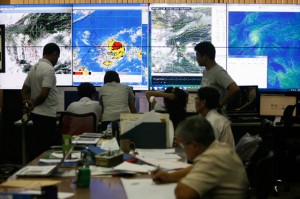THE National Disaster Risk Reduction and Management Council (NDRRMC) has placed all its municipal and regional units on alert in preparation for the onslaught
of Tropical Storm Glenda (international codename: Rammasun) when
it makes landfall in Luzon.
The NDRRMC executive director, Undersecretary Alexander Pama, on Monday said all Regional Disaster Risk Reduction and Management Councils (RDRRMCs) and all Office of Civil Defense (OCD) regional centers were under strict orders to monitor the situation in their areas of responsibility and take the necessary precautions.
“I have directed the RDRRMCs concerned through the OCD Regional Centers to undertake precautionary measures in their areas of responsibility and subsequently advised local RDRRMCs to initiate preemptive evacuation of families in low-lying and mountainous areas if the situation so warrants,” he added.
The Philippine Atmospheric, Geophysical and Astronomical Services Administration (Pagasa) said Glenda will make landfall in Aurora province if it maintains its current path or either in Isabela, Cagayan or Bicol Region if it changes direction.
The state weather bureau has placed under storm signals the whole of Metro Manila and 20 other provinces in Luzon.
Under Signal No.1 are Metro Manila, Masbate including Burias and Ticao Islands, Marinduque, Quezon including Pollilo Islands, Batangas, Cavite, Laguna, Rizal, Bulacan, Pampanga, Bataan, Zambales, Tarlac, Nueva Ecija, Pangasinan and southern Aurora.
Singal No.2 was raised in the provinces of Camarines Norte, Camarines Sur, Albay, Sorsogon and Catanduanes.
Glenda will bring moderate to intense rainfall in areas within its 400-km radius.
Pama said as a precautionary measure, residents in low-lying and mountainous areas under public storm warning signals were alerted against possible flashfloods and landslides.
He added that those living in coastal areas under Signal No. 2 were also warned against storm surges.
“Fishing boats and other small seacraft are advised not to venture out into the eastern seaboard of Luzon and the Visayas,” Pama said.
He said the NDRRMC is closely coordinating with the Departments of Social Welfare and Development (DSWD) and Interior and Local Government, Mines and Geosciences Bureau, Pagasa and other concerned agencies of the government for a cohesive action plan aimed at mitigating destructive effects of Glenda and zero or minimal casualties.
The storm is following a path similar to that taken by the deadly Typhoon Milenyo (Xangsane) that devastated the Philippines in 2006.
Milenyo hit Metro Manila on September 28 in that year, killing 213 people and injuring hundreds more and damaging P6 billion worth of infrastructure and agriculture.
The DSWD has readied food and non-food relief assistance to augment resources of local government units (LGUs) along the typhoon path.
Its field offices in Northern Luzon and Central Luzon that are along the path have prepared 78,608 family food packs for immediate distribution to the LGUs.
These offices also have a total of 209,875 assorted food items and 101,326 non-food items.
They have been directed by DSWD Secretary Corazon Soliman to continue coordinating with the LGUs in their respective areas to ensure that the needs of affected families will be immediately addressed.
Marikina City (Metro Manila) Mayor Del de Guzman also ordered city officials to aim for zero casualties as Storm Signal No. 1 was raised in Metro Manila and nearby provinces.
De Guzman advised the River Park Development Office to check alarm systems along the Marikina River, as well as the City Engineering Department to make sure that the three pumping stations located in low-lying areas are fully operational.


